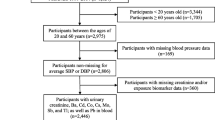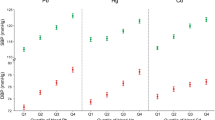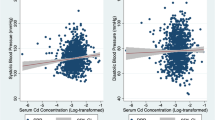Abstract
We examined the association of blood pressure with blood levels of cadmium, lead, and their combination in a representative sample of adults from South Korea (Korean National Health and Nutrition Examination Survey, 2008–2013). This cross-sectional study enrolled subjects who were at least 19 years-old, completed a health examination survey, and had blood measurements of lead and cadmium. We estimated the adjusted mean differences in diastolic and systolic blood pressure associated with doubling of blood lead and cadmium by regression of blood pressure against log2-transformed blood metals and their tertiles after covariate adjustment. Adjusted odds ratios for hypertension and prehypertension were calculated for log2-transformed blood levels of lead and cadmium and their tertiles. In the general population of Korea, blood lead level was associated with increased BP and risk of hypertension. Blood cadmium levels had a stronger association with elevated blood pressure and risk of hypertension than blood lead levels, and these associations remained significant after statistical adjustment for blood lead. The combination of blood lead and cadmium was more strongly associated with elevated blood pressure than exposure to each individual metal. In females, there was a stronger relationship between blood pressure and blood levels of these metals by analyzing interaction model. After adjustment for confounding factors, there were significant associations of blood pressure with the level of blood lead, cadmium, and their combination in adults from South Korea.
Similar content being viewed by others
References
Navas-Acien A, Guallar E, Silbergeld EK, Rothenberg SJ (2007) Lead exposure and cardiovascular disease–a systematic review. Environ Health Perspect 115:472–482
Staessen JA, Bulpitt CJ, Fagard R, Lauwerys RR, Roels H, Thijs L, Amery A (1994) Hypertension caused by low-level lead exposure: myth or fact? J Cardiovasc Risk 1:87–97
Nawrot TS, Thijs L, Den Hond EM, Roels HA, Staessen JA (2002) An epidemiological re-appraisal of the association between blood pressure and blood lead: a meta-analysis. J Hum Hypertens 16:123–131
Glenn BS, Stewart WF, Links JM, Todd AC, Schwartz BS (2003) The longitudinal association of lead with blood pressure. Epidemiology 14(1):30–36
Grandjean P, Hollnagel H, Hedegaard L, Christensen JM, Larsen S (1989) Blood lead-blood pressure relations: alcohol intake and hemoglobin as confounders. Am J Epidemiol 129(4):732–739
Moller L, Kristensen TS (1992) Blood lead as a cardiovascular risk factor. Am J Epidemiol 136(9):1091–1100
Staessen JA, Roels H, Fagard R (1996) Lead exposure and conventional and ambulatory blood pressure: a prospective population study. PheeCad Investigators. JAMA 275(20):1563–1570
Scinicariello F, Abadin HG, Murray HE (2011) Association of low-level blood lead and blood pressure in NHANES 1999-2006. Environ Res 111:1249–1257
Kim KR, Lee SW, Paik NW, Choi K (2008) Low-level lead exposure among South Korean lead workers, and estimates of associated risk of cardiovascular diseases. J Occup Environ Hyg 5(6):399–416
Korrick SA, Hunter DJ, Rotnitzky A, Hu H, Speizer FE (1999) Lead and hypertension in a sample of middle-aged women. Am J Public Health 89(3):330–335
Al-Saleh I, Shinwari N, Mashhour A, Mohamed G-D, Ghosh MA, Shammasi Z, Al-Nasser A (2005) Is lead considered as a risk factor for high blood pressure during menopause period among Saudi women? Int J Hyg Environ Health 208:341–356
Peters JL, Kubzansky L, McNeely E, Schwartz J, Spiro A 3rd, Sparrow D, Wright RO, Nie H, Hu H (2007) Stress as a potential modifier of the impact of lead levels on blood pressure: the normative aging study. Environ Health Perspect 115(8):1154–1159
National Toxicology Program (NPT) (2012) Health effects of low-level lead. U.S. Department of Health and Human Services
Järup L, Åkesson A (2009) Current status of cadmium as an environmental health problem. Toxicol Appl Pharmacol 238:201–208
Perry HM Jr, Erlanger MW (1973) Elevated circulating renin activity in rats following doses of cadmium known to induce hypertension. J Lab Clin Med 82:399–405
Perry HM Jr, Erlanger MW (1974) Metal-induced hypertension following chronic feeding of low doses of cadmium and mercury. J Lab Clin Med 83:541–547
Perry HM Jr, Erlanger MW, Perry EF (1977) Elevated systolic pressure following chronic low-level cadmium feeding. Am J Phys 232:H114–H121
Finch NC, Syme HM, Elliott J (2012) Association of urinary cadmium excretion with feline hypertension. Vet Rec 170:125
Thun MJ, Osorio AM, Schober S, Hannon WH, Lewis B, Halperin W (1989) Nephropathy in cadmium workers: assessment of risk from airborne occupational exposure to cadmium. Br J Ind Med 46:689–697
Satarug S, Nishijo M, Ujjin P, Vanavanitkun Y, Moore MR (2005) Cadmium-induced nephropathy in the development of high blood pressure. Toxicol Lett 157:57–68
Eum KD, Lee MS, Paek D (2008) Cadmium in blood and hypertension. Sci Total Environ 407:147–153
Tellez-Plaza M, Navas-Acien A, Crainiceanu CM, Guallar E (2008) Cadmium exposure and hypertension in the 1999–2004 National Health and Nutrition Examination Survey (NHANES). Environ Health Perspect 116:51–56
Lee BK, Kim Y (2012) Association of blood cadmium with hypertension in the Korean general population: analysis of the 2008-2010 Korean National Health and Nutrition Examination Survey data. Am J Ind Med 55:1060–1067
Gallagher CM, Meliker JR (2010) Blood and urine cadmium, blood pressure, and hypertension: a systematic review and meta-analysis. Environ Health Perspect 118:1676–1684
Staessen J, Bulpitt CJ, Roels H, Bernard A, Fagard R, Joossens JV, et al. (1984) Urinary cadmium and lead concentrations and their relation to blood pressure in a population with low exposure. Br J Ind Med 41:241–248
Beevers DG, Cruickshank JK, Yeoman WB, Carter GF, Goldberg A, Moore MR (1980) Blood-lead and cadmium in human hypertension. J Environ Pathol Toxicol 4:251–260
Revis NW, Zinsmeister AR, Bull R (1981) Atherosclerosis and hypertension induction by lead and cadmium ions: an effect prevented by calcium ion. Proc Natl Acad Sci U S A 78:6494–6498
Madden EF, Fowler BA (2000) Mechanisms of nephrotoxicity from metal combinations: a review. Drug Chem Toxicol 23:1–12
Kweon S, Kim Y, Jang M-J, Kim Y, Kim K, Choi S, Chun C, Khang Y-H, Oh K (2014) Data resource profile: The Korea National Health and Nutrition Examination Survey (KNHANES). Int J Epidemiol 43(1):69–77
Korean Centers for Disease Control and Prevention (KCDC) (2007) Report on in-depth analysis of the Third Korea National Health & Nutrition Examination Survey (KNHANESIII), 2005-health examination. KCDC
Jaccard J (2003) Interaction effects in multiple regression (2nd ed). In: Sage University papers series on quantitative applications in the social sciences. Sage, Thousand Oaks, pp. 07–072
Jaccard J (2001) Interaction effects in logistic regression. In: a SAGE University papers series on quantitative applications in the social sciences. Sage, Thousand Oaks, pp. 07–135
Centers for Disease Control and Prevention (CDC) (2014) Fourth National Report on human exposure to environmental chemicals. CDC. Available at: http://www.cdc.gov/exposurereport. Accessed 24 May 2014
Kim NS, Lee BK (2011) National estimates of blood lead, cadmium, and mercury levels in the Korean general adult population. Int Arch Occup Environ Health 84:53–63
Lee B-K, Kim Y (2014) Sex-specific profiles of blood metal levels associated with metal-iron interactions. Saf Health Work 5:113–117
Kim Y, Lobdell DT, Wright CW, Gocheva V, Hudgens E, Bowler RM (2015) Blood metal concentrations of manganese, lead and cadmium in relation to serum ferritin levels in Ohio residents. Biol Trace Elem Res 165:1–9
Park JU, Oh SW, Kim SH, Kim YH, Park RJ, Moon JD (2008) A study on the association between blood lead levels and habitual tobacco and alcohol use in Koreans with no occupational lead exposure. Korean J Occup Environ Med 20:165–173
Korean Ministry of Environment (2005) Report on the study of blood heavy metals of general population. Korean Ministry of Environment, Seoul
Moon CS, Zhang ZW, Shimbo S, Watanabe T, Moon DH, Lee CU, et al. (1995) Dietary intake of cadmium and lead among the general population in Korea. Environ Res 71(1):46–54
Järup L, Berglund M, Elinder CG, Nordberg G, Vahter M (1998) Health effects of cadmium exposure—a review of the literature and a risk estimate. Scand J Work Environ Health 24(Suppl 1):1–51
Soong YK, Tseng R, Liu C, Lin PW (1991) Lead, cadmium, arsenic, and mercury levels in maternal and fetal cord blood. J Formos Med Assoc 90:59–65
Berglund M, Akesson A, Nermell B, Vahter M (1994) Intestinal absorption of dietary cadmium in women depends on body iron stores and fiber intake. Environ Health Perspect 102:1058–1066
Zhang ZW, Moon CS, Watanabe T, Shimbo S, He FS, Wu YQ, Zhou SF, Su DM, Qu JB, Ikeda M (1997) Background exposure of urban populations to lead and cadmium: comparison between China and Japan. Int Arch Occup Environ Health 69:273–281
Ikeda M, Zhang ZW, Shimbo S, Watanabe T, Nakatsuka H, Moon CS, Matsuda-Inoguchi N, Higashikawa K (2000) Urban population exposure to lead and cadmium in east and south-east Asia. Sci Total Environ 249:373–384
Lee B-K, Kim Y (2013) Blood cadmium, mercury, and lead and metabolic syndrome in South Korea: 2005–2010 Korean National Health and Nutrition Examination Survey data. Am J Ind Med 56:682–692
Primatesta P, Falaschetti E, Gupta S, Marmot MG, Poulter NR (2001) Association between smoking and blood pressure: evidence from the health survey for England. Hypertension 37:187–193
Silbergeld EK, Schwartz J, Mahaffey K (1988) Lead and osteoporosis: mobilization of lead from bone in postmenopausal women. Environ Res 47(1):79–94
Symanski E, Hertz-Picciotto I (1995) Blood lead levels in relation to menopause, smoking, and pregnancy history. Am J Epidemiol 141(11):1047–1058
Webber CE, Chettle DR, Bowins RJ, Beaumont LF, Gordon CL, Song X, Blake JM, McNutt RH (1995) Hormone replacement therapy may reduce the return of endogenous lead from bone to the circulation. Environ Health Perspect 103(12):1150–1153
Korrick SA, Schwartz J, Tsaih SW, Hunter DJ, Aro A, Rosner B, Speizer FE, Hu H (2002) Correlates of bone and blood lead levels among middle-aged and elderly women. Am J Epidemiol 156(4):335–343
Nash D, Magder L, Lustberg M, Sherwin RW, Rubin RJ, Kaufmann RB, Silbergeld EK (2003) Blood lead, blood pressure, and hypertension in perimenopausal and postmenopausal women. JAMA 289(12):1523–1532
Kim SH, Kim Y, Kim N-S, Lee B-K (2014) Gender difference in blood cadmium concentration in the general population: can it be explained by iron deficiency? J Trace Elem Med Biol 28(3):322–327
Vaziri ND (2008) Mechanisms of lead-induced hypertension and cardiovascular disease. Am J Physiol Heart Circ Physiol 295(2):H454–H465
Muntner P, Menke A, DeSalvo KB, Rabito FA, Batuman V (2005) Continued decline in blood lead levels among adults in the United States: the National Health and Nutrition Examination Surveys. Arch Intern Med 165(18):2155–2161
U.S. EPA (2006) Air quality criteria for lead. EPA/600/R-05/114aF. Washington, DC: Office of Research and Development, National Center for Environmental Assessment. http://cfpub.epa.gov/ncea/CFM/recordisplay.cfm?deid=158823.
Satarug S, Nishijo M, Lasker JM, Edwards RJ, Moore MR (2006) Kidney dysfunction and hypertension: role for cadmium, p450 and heme oxygenases? Tohoku J Exp Med 208:179–202
Nordberg M, Nordberg GF (1975) Distribution of metallothionein-bound cadmium and cadmium chloride in mice: preliminary studies. Environ Health Perspect 12:103–108
Johnson DR, Foulkes EC (1980) On the proposed role of metallothionein in the transport of cadmium. Environ Res 21(2):360–365
Nordberg M (1984) General aspects of cadmium: transport, uptake and metabolism by the kidney. Environ Health Perspect 54:13–20
Åkesson A, Lundh T, Vahter M, Bjellerup P, Lidfeldt J, Nerbrand C, Samsioe G, Strömberg U, Skerfving S (2005) Tubular and glomerular kidney effects in Swedish women with low environmental cadmium exposure. Environ Health Perspect 113:1627–1631
Yoopan N, Watcharasit P, Wongsawatkul O, Piyachaturawat P, Satayavivad J (2008) Attenuation of eNOS expression in cadmium induced hypertensive rats. Toxicol Lett 176:157–161
Dillon HK, Ho MH (1991) Biological monitoring of exposure to chemicals: metals. Wiley, New York
Satarug S, Moore MR (2004) Adverse health effects of chronic exposure to low- level cadmium in foodstuffs and cigarette smoke. Environ Health Perspect 112:1099–1103
Abadin H, Ashizawa A, Stevens YW, Llados F, Diamond G, et al. (2007) Toxicological profile for lead. Agency for Toxic Substances and Disease Registry, Atlanta (GA)
Acknowledgments
This work was supported by the Soonchunhyang University Research Fund.
Author information
Authors and Affiliations
Corresponding author
Ethics declarations
Conflicts of Interest
The authors declare that they have no conflicts of interest.
Additional information
Byung-Kook Lee and Jaeouk Ahn contributed equally to this study.
Rights and permissions
About this article
Cite this article
Lee, BK., Ahn, J., Kim, NS. et al. Association of Blood Pressure with Exposure to Lead and Cadmium: Analysis of Data from the 2008–2013 Korean National Health and Nutrition Examination Survey. Biol Trace Elem Res 174, 40–51 (2016). https://doi.org/10.1007/s12011-016-0699-y
Received:
Accepted:
Published:
Issue Date:
DOI: https://doi.org/10.1007/s12011-016-0699-y




